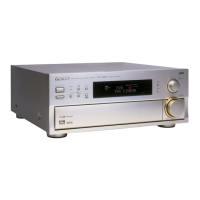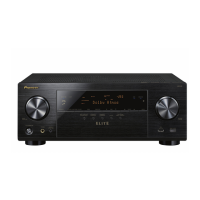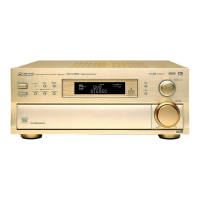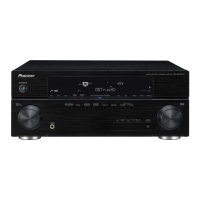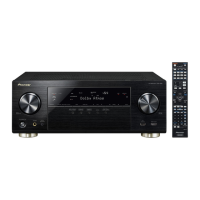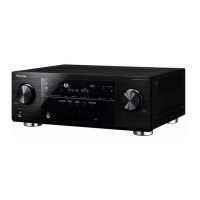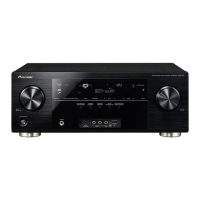Do you have a question about the Pioneer VSX-908RDS-G and is the answer not in the manual?
Details the MPEG audio decoding capability for discs and media.
Explains automatic decoding for DTS surround sound formats.
Covers automatic format switching for Dolby Digital and Pro Logic.
Describes the receiver's high-performance amplifier section.
Explains the FM RDS system for station information.
Highlights THX certification for enhanced movie sound.
Details modes for enhancing movie and audio-visual sources.
Explains Digital Signal Processing modes for sonic environments.
Describes a mode for optimal surround sound at low volumes.
Explains technology for filtering unwanted noise.
Introduces using the remote for other devices.
Notes the unit's low power consumption in standby.
Lists and describes the items included with the receiver.
Guides users on navigating and understanding the manual.
Instructions for setting up and using the remote control.
Defines the effective range and conditions for remote operation.
Guidelines for proper placement and ventilation of the unit.
Specifies requirements for heat dissipation and airflow.
Instructions on how to access the front panel.
Details analog audio connections for various components.
Explains how to connect video sources and displays.
Guides on making digital audio connections for surround sound.
Illustrates specific connection methods for disc players.
Describes connecting external decoders for specialized discs.
Instructions for connecting FM and AM antennas.
Details how to connect speaker systems (A/B) and impedance matching.
Explains how to set speaker impedance for optimal performance.
Provides guidance on optimal speaker positioning for surround sound.
Instructions for adding external amplifiers to the system.
Information on using the receiver's AC power outlets.
Overview of the receiver's front panel controls and indicators.
Detailed description of each front panel button's function.
Explains the information shown on the receiver's front panel display.
Details the meaning of various indicators on the display.
Introduces the functions of the supplied remote control.
Detailed description of each remote control button's function.
Rules for ensuring on-screen display functionality with video connections.
How to select the correct video system for OSD.
Overall guide to configuring surround sound settings.
How to specify connected speaker types and sizes.
Further instructions for configuring speaker settings.
Adjusting speaker delay for optimal surround sound effect.
Balancing the output volume of individual speakers.
Steps for adjusting speaker levels using test tones.
Setting the frequency cutoff for bass redirection to the subwoofer.
Adjusting peak levels for ultra-low bass (LFE) channels.
Compressing dynamic range for better sound at low volumes.
Assigning digital inputs to specific components.
Instructions for playing audio sources in stereo mode.
Using the DIRECT mode for accurate two-channel reproduction.
Explains various sound processing modes for different content.
Details specific Digital Signal Processing environments.
Using stereo mode and its associated controls.
Guide to choosing and adjusting sound modes.
How to play back advanced audio formats.
Specific instructions for playing discs with MPEG audio.
Selecting appropriate signal input for sources.
Using Digital Noise Reduction in STEREO mode.
Enjoying surround sound at low volumes.
Using external decoders via the front panel.
Details playback capabilities for high-resolution audio discs.
Boosting bass for music listening at low volumes.
How to modify bass and treble frequencies.
Controls for modifying the front panel display brightness.
Step-by-step guide to tuning radio stations.
Optimizing FM reception by selecting mono or stereo.
Using the RF attenuator for strong FM signals.
Tuning directly to specific radio frequencies.
Storing favorite radio stations in memory.
Retrieving stored radio stations.
Assigning custom names to preset stations.
Receiving and displaying RDS data from FM stations.
How to cycle through RDS information like RT, PS, PTY.
Finding stations based on program genre.
Enabling automatic switching for traffic or news broadcasts.
Guide to programming the remote for external devices.
Loading manufacturer codes for component control.
Detailed procedure for recalling preset codes.
Teaching the remote new commands.
Steps for copying commands from original remotes.
Controlling DVD/LD players using the receiver's remote.
Controlling VCRs and DVD recorders with the remote.
Controlling CD players using the receiver's remote.
Controlling MD recorders using the receiver's remote.
Controlling satellite tuners with the receiver's remote.
Controlling TVs using the receiver's remote.
Controlling cassette decks with the receiver's remote.
How to record analog audio signals to tape or MD.
Making exact digital copies of audio sources.
Recording audio and video signals to VCRs.
Programming sequences of commands for multiple components.
Executing programmed multi-operation sequences.
Programming a single button to turn off multiple components.
Controlling external video sources without changing receiver mode.
Adjusting the brightness of the remote control's backlight.
Erasing multi-operations, learned commands, or all settings.
Explains Dolby Digital format, channels, and encoding.
Details the DTS format, channels, and comparison with other systems.
Caution against entering DTS test mode to avoid data loss.
Describes MPEG audio encoding for high-quality sound.
Explains THX certification for movie sound accuracy.
Information on RDS features like PS, PTY, EON, and TA.
Lists program types available via RDS PTY data.
Recommendation to record preset station details.
Comprehensive list of remote control codes for various devices.
Guides on resolving common operational issues and malfunctions.
Technical details and performance metrics of the receiver.
| continuous power output (stereo mode) | 110 W + 110 W (DIN 1 kHz, THD 1 %, 8Ω) |
|---|---|
| continuous power output (surround mode) | FRONT: 110 W + 110 W, CENTER: 110 W, SURROUND: 110 W + 110 W (DIN 1 kHz, THD 1 %, 8Ω) |
| rated power output | 100 W + 100 W (20 Hz-20 kHz, THD 0.09 %, 8Ω) |
| input sensitivity/impedance (phono mm) | 4.7 mV/47 kΩ |
| input sensitivity/impedance (vcr 1, vcr 2, dvd/ld, tv/sat, video, cd, md/tape 1/cd-r, tape 2) | 335 mV/47 kΩ |
| phono overload level (t.h.d. 0.1 %, 1 kHz) | 120 mV |
| frequency response (phono mm) | 20 Hz to 20, 000 Hz ±0.3 dB |
| frequency response (vcr 1, vcr 2, dvd/ld, tv/sat, video, cd, md/tape 1/cd-r, tape 2) | 5 Hz to 100, 000 Hz dB–3 |
| output level/impedance | 335 mV/1 kΩ |
| tone control (bass) | ± 6 dB (100 Hz) |
| tone control (treble) | ± 6 dB (10 kHz) |
| loudness | +3 dB (100 Hz/10 kHz) |
| signal-to-noise ratio (phono mm) | 80 dB |
| signal-to-noise ratio (vcr 1, vcr 2, dvd/ld, tv/sat, video, cd, md/tape 1/cd-r, tape 2) | 101 dB |
| input sensitivity/impedance | 1 Vp-p/75 Ω |
|---|---|
| output level/impedance | 1 Vp-p/75 Ω |
| frequency response | 5 Hz to 10 MHz dB–3 |
| signal-to-noise ratio | 65 dB |
| frequency range | 87.5 MHz to 108 MHz |
|---|---|
| usable sensitivity | Mono: 15.2 dBf, IHF (1.6 µV/75 Ω) |
| 50 dB quieting sensitivity (mono) | 20.2 dBf |
| 50 dB quieting sensitivity (stereo) | 41.2 dBf |
| sensitivity (din) (mono) | 1.1 µV (S/N 26 dB) |
| sensitivity (din) (stereo) | 50 µV (S/N 46 dB) |
| signal-to-noise ratio (mono) | 76 dB (at 85 dBf) |
| signal-to-noise ratio (stereo) | 72 dB (at 85 dBf) |
| signal-to-noise ratio (din) (mono) | 62 dB |
| signal-to-noise ratio (din) (stereo) | 58 dB |
| distortion (stereo) | 0.6 % (1 kHz) |
| alternate channel selectivity | 70 dB (400 kHz) |
| stereo separation | 40 dB (1 kHz) |
| frequency response | 30 Hz to 15 kHz (± 1dB) |
| antenna input | 75 Ω unbalanced |
| frequency range | 531 kHz to 1.602 kHz |
|---|---|
| sensitivity (ihf, loop antenna) | 350 µV/m |
| selectivity | 30 dB |
| signal-to-noise ratio | 50 dB |
| antenna | Loop antenna |
| power requirements (uk model) | AC 230 V, 50/60 Hz |
|---|---|
| power requirements (european model) | AC 220 - 230 V, 50/60 Hz |
| power consumption | 400 W |
| power consumption (standby mode) | 1.0 W |
| ac outlets (switched) | Total 100 W MAX. |
| ac outlets (unswitched) | 100 W MAX. |
| dimensions | 420 (W) × 173 (H) × 470 (D) mm |
| weight (without package) | 14.9 kg |
